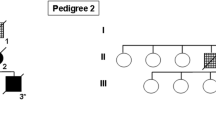Abstract
Recently intronic and exonic mutations in the Tau gene have been found to be associated with familial neurodegenerative syndromes characterized not only by a predominantly frontotemporal dementia but also by the presence of neurological signs consistent with the dysfunction of multiple subcortical neuronal circuitries. Among families, the symptomatology appears to vary in quality and severity in relation to the specific Tau gene mutation and often may include parkinsonism, supranuclear palsies, and/or myoclonus, in addition to dementia. We carried out molecular genetic and neuropathological studies on two patients from a French family presenting, early in their fifth decade, a cognitive impairment and supranuclear palsy followed by an akinetic rigid syndrome and dementia. The proband died severely demented 7 years after the onset of the symptoms; currently, his brother is still alive although his disease is progressing. In both patients, we found a Tau gene mutation in exon 10 at codon 279, resulting in an asparagine to lysine substitution (N279K). Neuropathologically, widespread neuronal and glial tau accumulation in the cortex, basal ganglia, brain stem nuclei as well as in the white matter were the hallmark of the disease. These deposits were shown by immunohistochemistry and immunoelectron microscopy, using a battery of antibodies to phosphorylation-dependent and phosphorylation-independent epitopes present in multiple tau regions. In the neocortex, tau-immunopositive glial cells were more numerous than immunopositive neurons; the deeper cortical layers as well as the white matter adjacent to the cortex contained the largest amount of immunolabeled glial cells. In contrast, some brain stem nuclei contained more neurons with tau deposits than immunolabeled glial cells. The correlation of clinical, neuropathological and molecular genetic findings emphasize the phenotypic heterogeneitiy of diseases caused by Tau gene mutations. Furthermore, to test the effect of the N279K mutation and compare it with the effect of the P301L exon 10 mutation on alternative splicing of Tau exon 10, we used an exon amplification assay. Our results suggest that the N279K mutation affects splicing similar to the intronic mutations, allowing exon 10 to be incorporated more frequently in the Tau transcript.
Similar content being viewed by others
Author information
Authors and Affiliations
Additional information
Received: 7 January 1999 / Revised, accepted: 3 March 1999
Rights and permissions
About this article
Cite this article
Delisle, MB., Murrell, J., Richardson, R. et al. A mutation at codon 279 (N279K) in exon 10 of the Tau gene causes a tauopathy with dementia and supranuclear palsy. Acta Neuropathol 98, 62–77 (1999). https://doi.org/10.1007/s004010051052
Issue Date:
DOI: https://doi.org/10.1007/s004010051052




